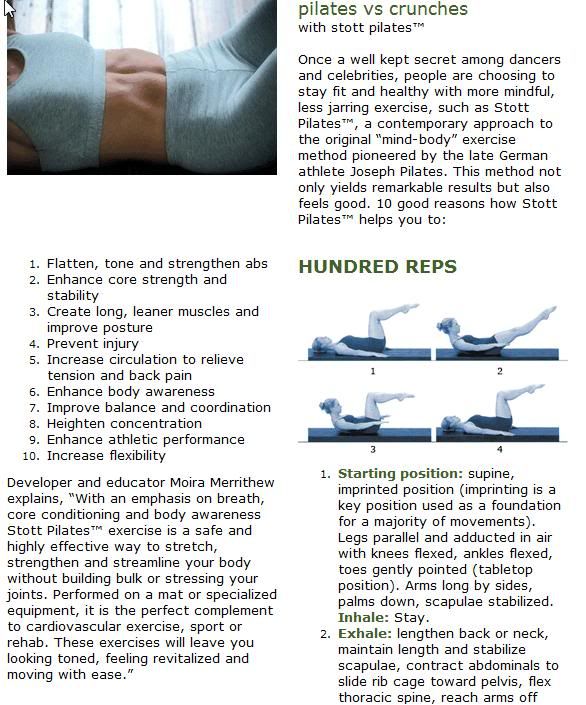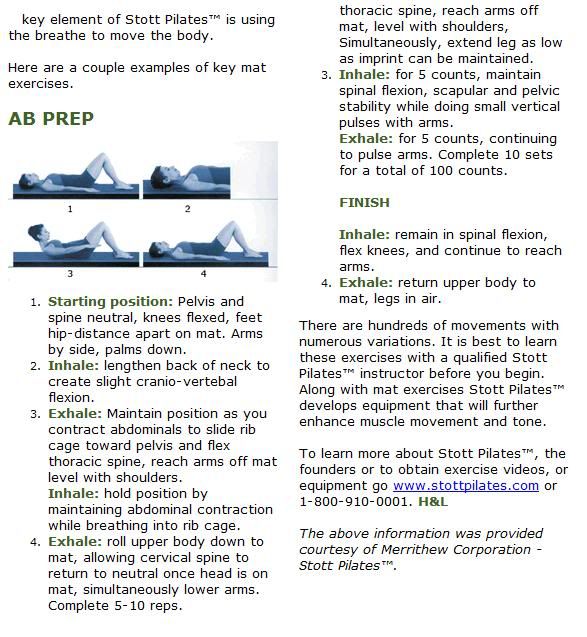So I'm saving this for a trackback when "that" time comes! lol.
Post-pregnancy secrets to a flatter stomach by Mizfit
Are crunches making you fat?
In my experience as a personal trainer, one of the most common requests from moms new and old are exercises to flatten the stomach back to pre-baby shape.
But after several years of sit ups and crunches–which come in addition to the abdominal trauma of the actual birthing process—what I usually find in the quest for a firmer mid-section is a set of conditions which prevent this from ever occurring. In order to understand what I mean, it is important to examine the subject. The typical Mom I train spends several hours sitting, wears heels on a regular basis and is quite often found anxiously chasing the kids around. Because all of these activities lead to tightness in the muscles which flex the hips forward (hip flexors, quads, etc), the common result is an increased arch in the back which causes the stomach to protrude (or anterior pelvic tilt)—regardless of bodyfat.
During a sit up or crunch, tightness in these muscles causes the lumbar spine to curl the trunk forward—rather than the hip– due to restricted motion at the hip. Much like bending a credit card will cause it’s surface to wear and eventually snap in half, repetitive crunching (or flexion) motions have been shown to be one of the leading causes of back pain.
With this in mind, it is no wonder that studies have shown that a heightened risk of back pain lingers years after pregnancy (It makes me wonder if these women tried crunches to fix the problem?!).
By contrast, the key to a flat stomach post pregnancy is not stronger abs, but rather the ability to consciously and unconsciously contract and control the abdominal muscles to provide support to the body. Much like a weightbelt, contracting the abdominals signals these muscles to tighten around the spine to provide increased support during daily life and exercises such as squatting and bending over.
In this way, the real life function of the core is to stabilize the trunk by preventing excessive movement. In relation to training for a flat stomach, this means that exercises such as planks and side planks which force us to hold the body still are a key ingredient which is often overlooked.
This type of “stability” based training has added benefit of this type of training is the ability to flatten the stomach on command!
But in order to do so, the key ingredient is learning (or re-learning) the ability to consciously tighten and release the stomach. In our work with clients training for a flat stomach, this comes down to a simple three step process:
Step #1: Breath and brace:
For anyone who has taken pilates, one of the major concepts in this form of exercises is learning proper breathing during abdominal exercise. This type of breathing means taking deep, measured through the nose and allowing the belly to fill with air and expand outward without lifting the chest.
By contrast, inhaling through the mouth causes us to lift the chest and shoulders to initiate each breath without proper motion at the diaphragm. In this upper chest breathing pattern, the diaphragm does not move downward causing increased tension in the muscles of the low back—reinforcing the excess arching of the back described above.
Deep breathing sets the tone for the entire core by allowing the diaphragm to move properly. This is why it is important to practice deep breathing along with your training described below. Once this is accomplished, our next challenge is to integrate deep breathing with conscious abdominal contractions.
Described in the accompanying video, engaging the abdominal brace during abdominal exercises ensures the right muscles are moving at the right times. In our system, this bracing exercise is performed as a warm up drill to remind clients to brace during abdominal exercises. Our general progression begins with five 5 second holds and adds 5-10 seconds per week until brace can be maintained for 30 seconds. We will then move on to the next level.
Deep breathing video link: http://www.youtube.com/watch?v=QZJPTQKc9gU
Step #2: Crunchless core training:
According to renowned physical therapist Shirley Sahrmann the primary role of the abdominals is to provide isometric support and limit rotation and extension of the trunk at the lumbar spine. A large percentage of low back problems occur because the abs do not maintain tight control over the waistline.
With that said, my other issue with crunches is that they target primarily the rectus abdominus (or center of the stomach). Because this muscle cannot control rotation, crunches do little to protect the back against pain.
Combine this with daily activities such as hunching forward over a computer and bending over to pick up the kids and we literally spend hours in a crunched position every day! And while the rectus becomes tightened due to excessive use, a major strength imbalance often exists between this muscle and the external oblique’s (side abs)
Much like the traditional six pack, the external also act to prevent excessive arching of the back while also preventing rotation. In most cases, this means our strategy with most clients training for a flat stomach is to ditch crunching motion in favor of movements which strengthen the external oblique’s (side abdominals).
In the above circuit, we combine an exercise which involves movement of the arms to target the external oblique along with two “stability” exercises to train support of the core. Performed along with the brace as a warm up, this strategy is the ideal solution for systematically developing a flat stomach while strengthening the abs for daily life.
In terms of progression, we generally begin with eight reps of the first exercise and add two per week until reaching 12. We will then move to a harder progression. For the plank and side plank, begin by holding for 20 seconds and add 5-10 seconds per week until reaching 45 seconds. Then increase the difficulty as described in the video.
Core circuit video: http://www.youtube.com/watch?v=NtE9T2mCvDE
Step #3: Taking it to the street:
After performing core training on the floor, the ultimate goal is to transfer your results to standing. This means integrating the bracing technique in to daily activities which test the ability to remain strong and stable. Combined with our core training, practicing the brace in standing positions is truly the secret to allowing us to maintain a flat stomach at all times during the day.
Standing Brace video: http://www.youtube.com/watch?v=0LlpZcoak2I
Program Guidelines:
- Perform five reps of 5-10 second holds of the abdominal brace exercise as a warm up before your abdominal circuit
- Perform deep breathing while maintaining your brace
- Perform eight reps of each exercise listed in the abdominal circuit.
- Perform these exercises back to back three times
- Add two reps and/or 5-10 seconds per exercise for 3-4 weeks before moving to next progression
- Practice the standing bracing drill several times per day in order to build endurance and control in the abs
- In order to progress this drill, add 5-10 seconds per week until reaching 45 seconds. Then move on to the next progression
Program warm up:
- Floor brace progression
Abdominal Circuit:
Plank w/push up
Plank hold
Side plank hold
Homework:
- Standing brace practice progression
Additional must-reads on pilates vs crunches




No comments:
Post a Comment